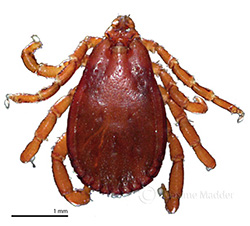Authors: Prof Maxime Madder, Prof Ivan Horak, Dr Hein Stoltsz
Introduction
Ticks are blood-sucking arthropods found in virtually all terrestrial regions of the planet. Globally, approximately 900 species of ticks are recognized of which about 700 species are ixodid or hard ticks and 200 species are soft ticks. Approximately 200 ixodid and 40 argasid species are present in the Afrotropical region but only a small number are of veterinary and medical importance. Many of the ticks and tick-borne diseases occur usually in specific geographical areas but with globalisation and climate change their range may be expand and even spread intercontinentally.
It is customary to consider domestic animals as the preferred hosts of those tick species that transmit diseases to them. However, the only ticks that nearly exclusively parasitize these animals are the introduced Asiatic blue tick, Rhipicephalus (Boophilus) microplus of cattle, the shiny Hyalomma, Hyalomma scupense of North Africa, and the cosmopolitan kennel tick, Rhipicephalus sanguineus of domestic dogs. The vast majority of indigenous ticks in the sub-Saharan region are parasites of wildlife, and indeed a large number of species would be unable to complete their life cycles if there were no wild hosts available. Many of the tick species deemed to be parasites of domestic cattle, sheep, goats, horses and pigs are frequently more abundant or prevalent on equivalently-sized or even smaller wild animals.

Rhipicephalus sanguineus (male) |
Failure to control ticks and tick-borne diseases effectively is a major factor limiting livestock production. The worldwide economic loss and the additional burden of protecting livestock against ticks and tick-borne diseases are estimated to be in the billions of dollars annually.
